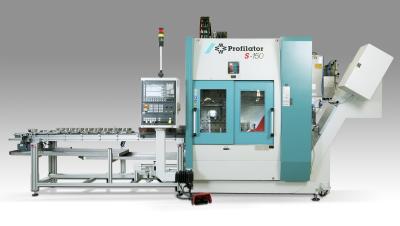
GMTA, the North American distributor of Profilator, has added new machines using the process modules it already supplies. Profilator is suitable when customers require complex machining processes to be carried out effectively, efficiently and with high precision.
Today, an operator working on a modern machine expects a flexible manufacturing process, short cycle times, reduced investment and running costs. With these requirements in mind, Profilator offers polygon and face slot machining, gear tooth pointing, chamfering and deburring, gear and spline cutting, shifter stop machining and Scudding.
The polygon turning unit is used for castle teeth machining on automotive gearbox parts. The rotating cutterhead is synchronized with the workplace spindle and a front face coupling is produced with the carbide insert arrangement and the transmission ratio. With additional inserts on the same cutter head, the part can be deburred. In gear tooth pointing, the pointing tower can be used in both rotative and indexing modes. Settings and corrections are made through the new Ergo Control SIMPS (Profilator Simplified Integrated Machine Programming System).
For the chamfering and deburring of splines, gear wheels and shafts, Profilator uses the ZEM series gear deburring machines. This vertical, single spindle gear deburring machine offers clear advantages over conventional deburring machines. Gear cutting is used both for the Profilator rotative gear cutting with inserts and for hobbing. Through the application of Schlagzahn tools and carbide inserts, customers achieve the most economical manufacture of splines, gears, involute gears and front face gears. The shifter stop is synchronized so that the tool machines each tool flank. Lastly, Scudding can be used for a wide range of symmetrical gear applications as well as non-symmetrical gear or profile applications such as belt pulleys and synchronize gears. The same machine can be used for internal and external Scudding applications.
Profilator developed the S-type machine. This is a compactly and modularly designed, vertical single spindle pick-up gear cutting machine.Machines in the S series are better than broaching and most applications feature a dry machining process. All machine components are designed for especially high static stiffness and optimal dynamic behavior. Furthermore, the machine’s twin spindle arrangement speeds up the process considerably.
A control panel and a media container are installed on the rear of the machine bed. The workplace flow direction is variable. S-type machines are available in three sizes, namely Profilator S-150, Profilator S-250 and Profilator S-500. Profilator S-150 has a part diameter up to 150 mm, while Profilator S-250 and S-500 have a part diameter up to 250 mm and 500 mm, respectively.
Contact Details
Related Glossary Terms
- broaching
broaching
Operation in which a cutter progressively enlarges a slot or hole or shapes a workpiece exterior. Low teeth start the cut, intermediate teeth remove the majority of the material and high teeth finish the task. Broaching can be a one-step operation, as opposed to milling and slotting, which require repeated passes. Typically, however, broaching also involves multiple passes.
- chamfering
chamfering
Machining a bevel on a workpiece or tool; improves a tool’s entrance into the cut.
- static stiffness
static stiffness
Relates to the machine tool and is measured in pounds per inch. Static stiffness indicates how many pounds of force it takes to deflect the spindle a linear distance of 1" in a given direction. See dynamic stiffness; stiffness.
- stiffness
stiffness
1. Ability of a material or part to resist elastic deflection. 2. The rate of stress with respect to strain; the greater the stress required to produce a given strain, the stiffer the material is said to be. See dynamic stiffness; static stiffness.
- turning
turning
Workpiece is held in a chuck, mounted on a face plate or secured between centers and rotated while a cutting tool, normally a single-point tool, is fed into it along its periphery or across its end or face. Takes the form of straight turning (cutting along the periphery of the workpiece); taper turning (creating a taper); step turning (turning different-size diameters on the same work); chamfering (beveling an edge or shoulder); facing (cutting on an end); turning threads (usually external but can be internal); roughing (high-volume metal removal); and finishing (final light cuts). Performed on lathes, turning centers, chucking machines, automatic screw machines and similar machines.
